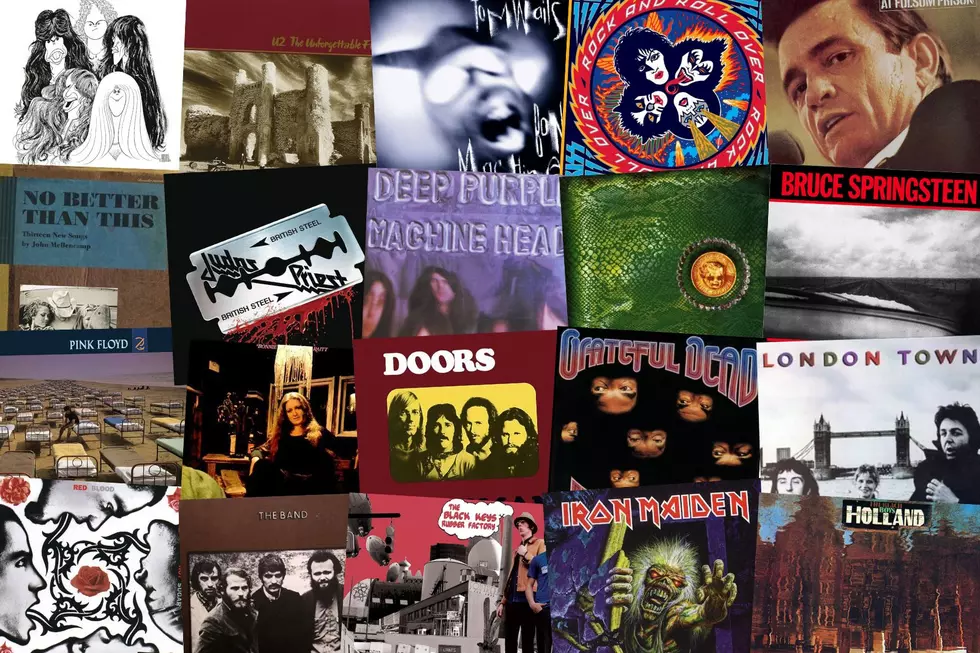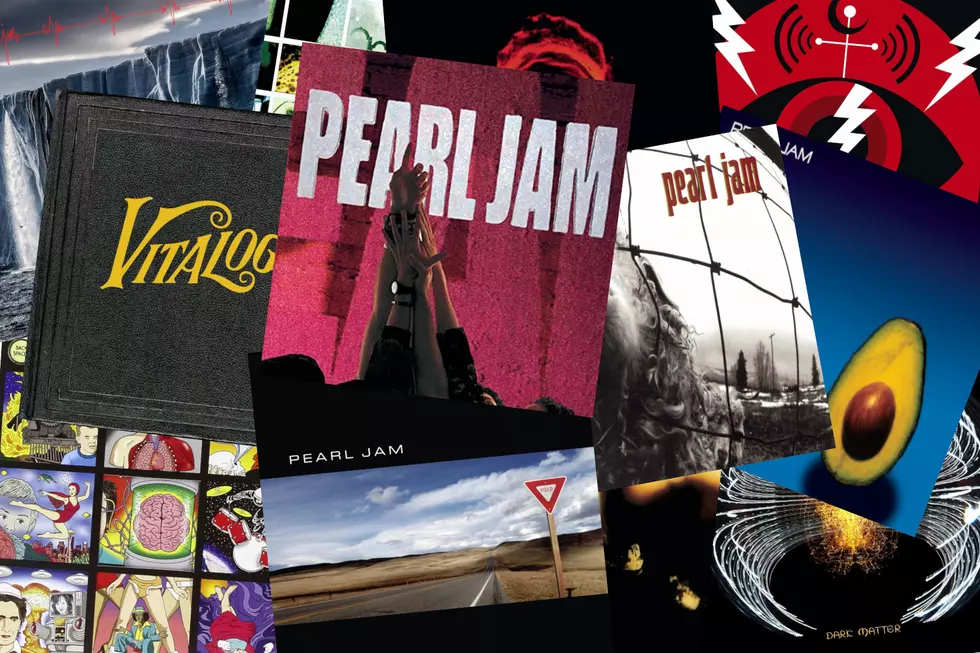
Top 10 Mellotron Songs
Today, we’re honoring one of the great, pre-digital age instruments with the Top 10 Mellotron Songs. In an era in which you can recreate almost any sound on a laptop or smart phone, the Mellotron seems prehistoric – pressing keys on the organ-like instrument would trigger tape loops of a single note played by orchestral instruments. First introduced in 1963, the Mellotron was designed to perfectly mimic these sounds, but due to the natural wobble and flutter of tapes, the result was often a strange, other-worldly effect.
It’s no wonder that the Mellotron became quite popular with top-notch rock bands during the psychedelic era, and continued to be in-demand with progressive rockers throughout the ’70s (until more effective and more reliable electronic synthesizers became the standard). Below, we pay tribute to this antiquated instrument with 10 songs that best showcased its strange sounds.
- 10
‘Kashmir’
Led ZeppelinFrom: ‘Physical Graffiti’ (1975
Of all the tracks on the Top 10 Mellotron Songs, ‘Kashmir’ might pose the biggest challenge for picking out the Mellotron. That’s because John Paul Jones employed both Mellotron “strings” and an actual string section (not to mention brass) to accompany the Eastern-tinged epic, and it’s not always easy to determine if you’re hearing the ’tron, the real deal or a combination of both. The consensus is that Jones’s fake strings are heard during the “All I see turns to brown…” bridge (starting around 3:25) and join up with the actual strings in the tune’s closing minutes, adding a weird and wonderful effect. While touring, Jones played the string parts on a Mellotron…provided it was working.
- 9
‘Phaedra’
Tangerine DreamFrom: ‘Phaedra’ (1974)
The cosmic title track from this influential album takes up all of side one, leaving enough room for Tangerine Dream founder Edgar Froese’s Mellotron to hum across the universe and descend onto the plateaus of a distant planet. ‘Phaedra’ is unique for its employment of a Moog analog sequencer, which serves as the composition’s mechanical engine. But the track’s humanity comes from the epic sweep of Froese’s one-man orchestra – simultaneously menacing, depressed and beautiful.
- 8
‘Every Christian Lion Hearted Man Will Show You’
The Bee GeesFrom: ‘Bee Gees’ 1st’ (1967)
Long before they came down with a case of ‘Saturday Night Fever,’ the Bee Gees crafted great pop-rock songs with inventive arrangements. That’s certainly the case with this tune off the band’s third LP (although it was called ‘Bee Gees’ 1st’). ‘Every Christian…' is a sort of cross between Beatles-esque harmonies and Moody Blues-y atmosphere, which is where Maurice Gibb’s droning Mellotron comes in, paired with Robin and Barry’s low-register chanting. Maurice’s ominous “string section” gives the song its edge, although he had to play the part on an organ in concert, because those Mellotrons were just too heavy to lug around.
- 7
‘2000 Light Years from Home’
The Rolling StonesFrom: ‘Their Satanic Majesties Request’ (1967)
During the Stones’ most sonically experimental years, Brian Jones was the band’s not-so-secret weapon. Jones played the Mellotron on a bunch of the Stones’ psychedelic material – creating the “brass” parts on ‘We Love You’ and ‘She’s a Rainbow’ as well as the mind-bending strings on ‘2000 Light Years from Home.’ While Mick Jagger and the boys are zooming through space, Brian conjures the ethereal galaxies that swirl around this off-kilter classic.
- 6
‘And You and I’
YesFrom: ‘Close to the Edge’ (1972)
This is the standout track on an album that was positively loaded with Mellotron, with keyboardist Rick Wakeman using the instrument to simulate strings, brass and flutes. Wakeman’s Mellotron lends a mile-wide scope to the ‘Eclipse’ section of the 10-minute track, combining with Steve Howe’s lap steel guitar in a majestic musical moment that extends somewhere close to the edge of the horizon.
- 5
‘Space Oddity’
David BowieFrom: ‘David Bowie’ (1969)
Speaking of Rick Wakeman – before the keyboardist joined up with Yes, he was a session player tapped to play on what would become David Bowie’s first hit. The plan was for Wakeman to use the Mellotron to merely lay down a guide track that would later be replaced by an actual orchestra. But, producer Tony Visconti ended up deciding that Wakeman’s part (and the wobbly, spacey sound of the ’tron) was a better fit, so Major Tom went to outer space on a Mellotron-propelled rocketship.
- 4
‘Watcher of the Skies’
GenesisThis song holds a special place on the Top 10 Mellotron Songs – the gigantic sound that Tony Banks produced using block chords proved so popular that the next version of the Mellotron actually came with a ‘Watcher Mix’ sound. Banks, who had acquired his Mellotron from King Crimson, noticed that, because of how the ’tron tapes were recorded, some chords didn’t work at all, while others combined for a powerful song. On the ‘Watcher of the Skies’ intro, Banks combined strings and brass to set the tone for the seven-plus-minute tune, not to mention all of the prog landmark ‘Foxtrot.’
- 3
‘Strawberry Fields Forever’
The BeatlesSingle (1967)
‘Strawberry Fields Forever’ features one of the most memorable uses of the Mellotron in rock and roll history: the flute-like intro that Paul McCartney plays to open the psychedelic classic. The flutes continue wafting through the song’s first minute, until Paul is buried by real cellos and brass. Paul and the Mellotron (purchased on the advice of the Moody Blues’ Mike Pinder) are resurrected in the fade-in coda, where the instrument, on the “swinging flutes” setting, sounds like a melodious swarm of insects.
- 2
‘Forever Afternoon (Tuesday?)’
The Moody BluesFrom: ‘Days of Future Passed’ (1967)
Although the Moodies’ second album featured plenty of actual orchestration, keyboardist Mike Pinder also drenched the album in Mellotronned strains of strings, brass and more, making ‘Days of Future Passed’ the first major ’tron album. That’s fitting, given that Pinder was a former employee of Mellotron manufacturer Streetly Electronics, and even customized his instruments to make the most out of their unusual sounds. Those are in full effect on this ‘Days’ track (released as the edited single ‘Tuesday Afternoon’), from the ghostly background drone to eerie oboe-like sound to the flute flutter that accompanies the “I’m looking at myself…” interlude. Although the second time you hear that flute part, it’s real – performed by band member Ray Thomas. You never know what you might get, they’re so Moody...
- 1
‘The Court of the Crimson King’
King CrimsonFrom: ‘In the Court of the Crimson King’ (1969)
This stately ‘Court’ seems to stretch on forever, enhanced by Ian McDonald, who pulls the strings (actually a Mellotron on the three violins setting). The fake strings, combined with the “ahhh-ing” chorus, are the main melodic component in this glorious album-closer, which has a regal, dour elegance in perfect contrast to frenzied opener ‘21st Century Schizoid Man.’ McDonald, King Crimson’s founding multi-instrumentalist, wrote the epic finish to the band’s first album, but left the group after that amazing debut. This track alone, which tops our list of the Top 10 Mellotron Songs, makes him a Mellotron legend.
More From Ultimate Classic Rock









